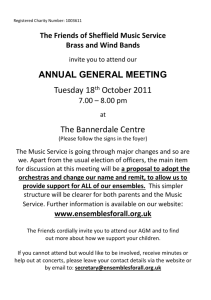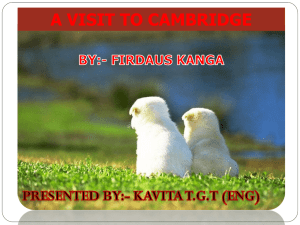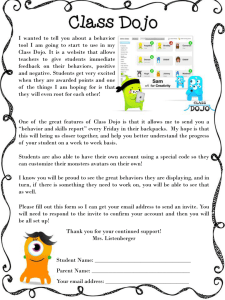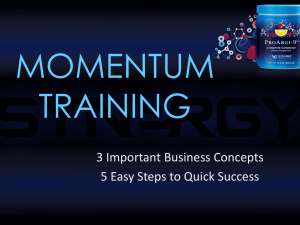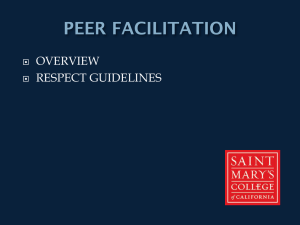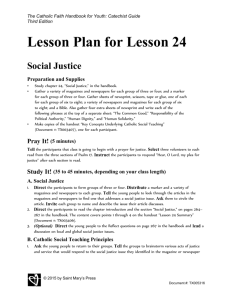HEEDING THE CALL A Tapestry of Faith Program for Youth
advertisement
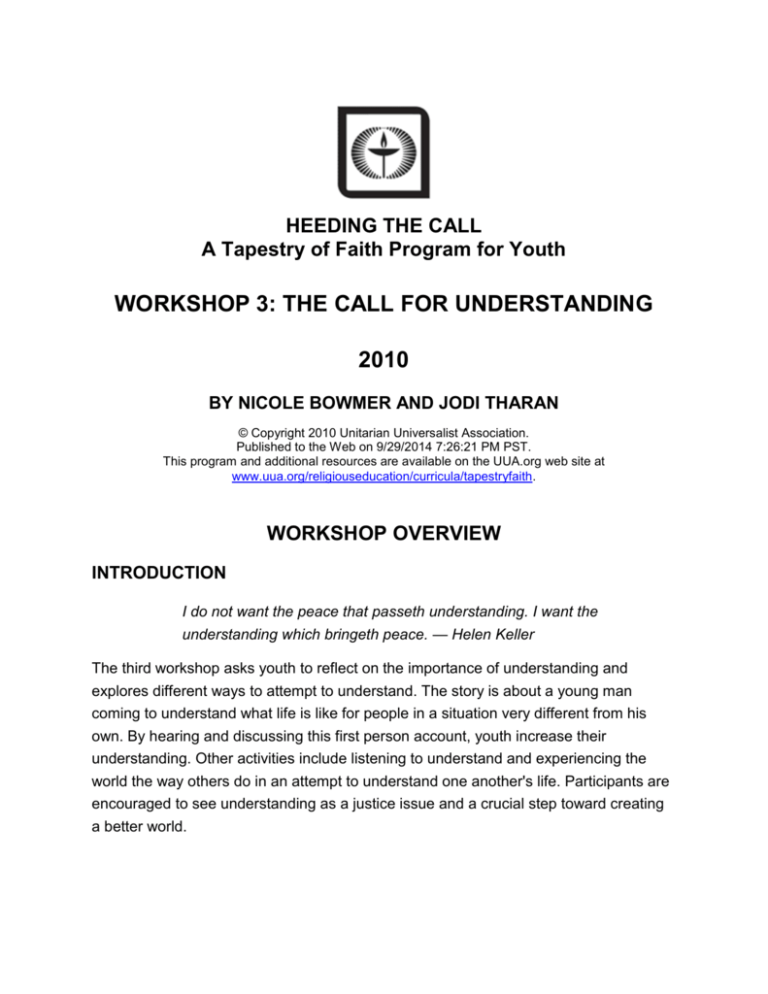
HEEDING THE CALL A Tapestry of Faith Program for Youth WORKSHOP 3: THE CALL FOR UNDERSTANDING 2010 BY NICOLE BOWMER AND JODI THARAN © Copyright 2010 Unitarian Universalist Association. Published to the Web on 9/29/2014 7:26:21 PM PST. This program and additional resources are available on the UUA.org web site at www.uua.org/religiouseducation/curricula/tapestryfaith. WORKSHOP OVERVIEW INTRODUCTION I do not want the peace that passeth understanding. I want the understanding which bringeth peace. — Helen Keller The third workshop asks youth to reflect on the importance of understanding and explores different ways to attempt to understand. The story is about a young man coming to understand what life is like for people in a situation very different from his own. By hearing and discussing this first person account, youth increase their understanding. Other activities include listening to understand and experiencing the world the way others do in an attempt to understand one another's life. Participants are encouraged to see understanding as a justice issue and a crucial step toward creating a better world. GOALS This workshop will: Identify understanding as a quality needed to bring about a more just world Encourage youth to increase their understanding of justice issues Explore the meaning of "abilities" Ask youth to consider their own abilities and the abilities of others Reinforce the inherent worth and dignity of every person and all of their abilities (first Principle). LEARNING OBJECTIVES Participants will: See a commitment to understanding as an important quality in justice-making Practice different ways to gain understanding Appreciate their own abilities and recognize that abilities are defined by society Examine their preconceptions about "disabilities" and have the opportunity to revise them. WORKSHOP-AT-A-GLANCE Activity Minutes Opening 5 Activity 1: Story — Peace Begins with Me 10 Activity 2: Artists — Head to Toe 15 Activity 3: Abled and Less Abled 10 Activity 4: Nonviolent Communication 15 Faith in Action: Understanding Our Community Faith in Action: Are We Accessible? Closing 5 Alternate Activity 1: Can You Guess Who I Am? 15 SPIRITUAL PREPARATION Think about ways your understanding of the need for greater justice has developed throughout your life. Can you remember listening to people whose experiences have opened your eyes? Have you ever spent the night in a shelter and missed the comforts of home, had to use crutches and found yourself not able to access buildings, or replicated another experience common to marginalized people? Have you read first person accounts and imagined yourself into the story? What other ways have you grown to a greater understanding of social justice in our world? You are helping young people understand more by leading Heeding the Call. Are you learning from this experience? Use your Justicemakers Guide to keep track of your experiences and reflections. WORKSHOP PLAN OPENING (5 MINUTES) Materials for Activity Chalice, candle, lighter or LED/battery-operated candle Newsprint, markers and tape Preparation for Activity Write the chalice lighting words on newsprint and post. Description of Activity Welcome first-time participants. Invite youth to go around the circle and say their names. Ask if anyone would like to share anything noted in their Justicemakers Guide since the last meeting. Light the chalice, or invite a participant to do so, and recruit a volunteer to read the chalice lighting words: Let the light of this chalice lead us on the path to greater understanding, deeper knowledge, and greater truths. Ask the group to be silent for a moment as they reflect on the words. End the silence with "So be it," or other appropriate words. Tell the group that today's theme is "understanding." Ask for volunteers to share what they think understanding has to do with justice work. ACTIVITY 1: STORY — PEACE BEGINS WITH ME (10 MINUTES) Materials for Activity Copy of the story "Peace Begins with Me (included in this document) " Optional: Copies of Heifer International's World Ark magazine or printouts of stories from World Ark online (at www.heifer.org/site/c.edJRKQNiFiG/b.201480/) Preparation for Activity Read the story until you are comfortable presenting it. Optional: Make copies of the story for youth to share and read along. Description of Activity Youth explore individual roles in creating peace. Tell or read the story. Follow the story with a discussion. Did Raziq experience anything in Sierra Leone that you consider unjust? What spheres of influence did Raziq influence in this story? Did Raziq become an ally to anyone in this story? If so, how did he ally with them? Raziq refers to the seven Principles as a litmus test. What does that mean to you? Do you think Raziq understands some things by the end of his trip that he did not understand before? What might they be? What new understandings did the story bring to you? Have you ever read a true, first person account like this before that inspired you to act? (You might mention the stories that accompany the Unitarian Universalist Service Committee's Guest at Your Table Program, commercials for Save the Children, or show some of the stories from World Ark, the magazine for Heifer International.) Many organizations working for social justice use stories of truelife experiences to make their point. Why do you think this is effective in soliciting action? Including All Participants Have enough copies of the story to share for youth who are visual learners. ACTIVITY 2: ARTISTS — HEAD TO TOE (15 MINUTES) Materials for Activity Leader Resource 1, Mouth and Foot Paintings, (included in this document) or order prints online (at www.mfpausa.com/) One crayon for each youth Masking tape Music player A composition from late in Beethoven's life (Ninth Symphony or String Quartet 14 are possibilities) Preparation for Activity Have the Beethoven recording ready to play. Be prepared to help the youth re-focus during the coloring section of the activity. There may be giggles as a healthy release for the awkwardness. Allow space for that while also using the questions to re-focus the group, if needed. Optional: Purchase a print from the Mouth and Foot Paintings Association (at www.mfpausa.com/). The quality will be better and you will help a worthwhile organization. You can order note cards, calendars, or prints. Prices range from 10 dollars to 25 dollars. If you use artwork from artists other than Nguyen or Flores, make sure you attribute the correct artists. Description of Activity Youth participate in a coloring activity that will help them get closer to understanding an aspect of the lives of differently-abled individuals. Say, in your own words: Hearing stories about people's experiences is one way to increase our understanding of the world. There are other ways, too. One other way is to try to experience the world the way other people do. In this activity, I'm going to ask you to experience life as an artist. Here are a couple of the paintings done by artists. (Pass around Leader Resource 1, Mouth and Foot Paintings.) You may ask what these lovely paintings have to do with social justice? They were painted by people who are differently-abled. These artists belong to a group called the Mouth and Foot Painting Artists or mfpa. None of these paintings were done by hand. Tony Nguyen and Onix Flores painted these pictures by holding a brush in either their mouth or their foot. Does that sound hard? Let's see how hard it is. Guide participants to the art supplies. Let youth know that they will be creating their own piece of art and encourage them to focus not on the end product, but on how it feels to use their bodies differently. Introduce the Beethoven music and ask youth if they know what is special about this composition. (Beethoven composed this toward the end of his life when he was completely deaf.) Ask youth to tape a blank sheet of paper to the wall directly in front of their face. Then choose a crayon and use their mouth to draw a picture of whatever they like. They might try to replicate one of the mfpa paintings. Remind them that the quality of the drawing is not the focus. Allow five minutes for drawing and then have the youth gather in the circle for a discussion with these questions: Did they feel less able? Less capable? In the area of art, are these "disabled" artists more "enabled" than many in our group? Can they imagine someone—perhaps at their school—who feels less able in one subject yet might be completely capable in another subject or area of life outside of school? Did you gain any understanding in this activity that you can share with the group? What does this have to do with social justice? Make sure your discussion includes the importance of seeing people as multi-dimensional: no one is just their ability or just their gender or just their race. Discuss the value of supporting people in marginalized communities so they can live up to their potential. In a truly just world, everyone is enabled to contribute their talents to the community, like painting beautiful pictures. Have there been other times when you have glimpsed what life may be like for someone in a marginalized community? Invite youth to share their previous experiences. If the group is having a hard time thinking of examples, leaders may share. You may also ask if anyone has ever had to temporarily use crutches or a wheelchair. What did they learn? Note that accessibility is a term frequently used when evaluating whether all resources are available to the differentlyabled. Do you think trying to replicate experiences of oppressed people is an effective way to increase understanding of justice issues? Why or why not? Mention that the replicated experience is not the true experiences of people in that situation because replicators choose to have the experience and are free to choose not to have the experience. Including All Participants For youth with mobility issues, invite them (and anyone) to draw with their toes. ACTIVITY 3: ABLED AND LESS ABLED (10 MINUTES) Materials for Activity Newsprint, markers and tape Pens or pencils Lined paper Description of Activity Youth reflect on the word "disabled." Ask youth what comes to mind when they hear the terms "disabled people" or "a disabled person." If there is a youth in the room with an obvious physical disability, invite them to go first by sharing what "disabled" means to them. Does being disabled mean that all abilities have been completely disconnected? Let the group know that this next activity will explore a different way to look at the word "disabled." Pass out the paper. Invite youth to come up with three subjects or areas in which they feel "abled" and three subjects or areas in which they feel "less abled." Encourage them to think of areas in school as well as out of school. What about baking or cooking? What about with athletics, whether a team sport like basketball, or a game like hackysack? What about physical conditions like allergies or asthma? What about in drama or choir or with a musical instrument? Invite youth to write their lists on the paper using their dominant hand to write their "abled" list and their non-dominant hand to write their "less abled" list. Allow five minutes for youth to complete their lists. Once everyone is finished, invite youth to create a group "Abled" and "Less Abled" list by sharing subjects or areas that they feel comfortable sharing whether or not those are included on their lists. Capture the list on newsprint. When the lists are complete, invite youth to consider how ideas of "abled" and "disabled" are socially constructed. What does society consider "normal"? What does it value? Are some abilities more valued than others? Can a person lose an ability? Gain an ability? We all have items on our "less abled" list. Are we all "disabled"? Invite youth to consider the other items on both lists and discuss how an item on one list could become an item on the other if society was structured differently. Invite volunteers to share their ideas. Close by asking, "Does it make sense to table someone 'disabled' because they are unable or less able to do something others can do?" ACTIVITY 4: NONVIOLENT COMMUNICATION (15 MINUTES) Materials for Activity Newsprint, markers and tape Preparation for Activity Write this list on a sheet of newsprint: Observation, Feelings, Needs, Request Write these two sentences on a separate sheet of newsprint: 1. My sister is such a pig. 2. My sister leaves her dirty socks on the bathroom floor. Write "Needs" on a separate sheet of newsprint: Air, Food, Water, Rest, Shelter, Acceptance, Appreciation, Love, Respect, Trust, Warmth, Beauty, Harmony, Fulfillment, Movement/Exercise, Meaning, Self-Worth Description of Activity Youth explore the power of communication in creating justice. Explain that one of the most often-overlooked ways of creating justice is taking time to listen to each other, to establish a connection with others. Being aware of your own emotions and needs as well as the emotions and needs of others can go a long way toward justice. After all, conflict arises when we cannot voice our needs or we think our needs are not being taken into consideration. Instead of saying: "I am sad; I need your consideration," we may say, "All you think about is yourself! You're so mean!" One way of focusing on feelings and needs when we communicate is to remember the giraffe. The giraffe is most commonly known for having one of the longest necks on the planet, but it also has the biggest heart of any animal that walks on land. The giraffe reminds us to speak from our hearts. Invite youth to say aloud feelings they have when their needs are being met. You could prompt with this example, "When you have been nervous about a piano recital and you end up playing really well, you feel... ." Examples are: amazed, appreciative, grateful, confident, energetic, glad, inspired, joyous, optimistic, relieved, surprised, touched, comfortable, eager, fulfilled, hopeful, intrigued, moved, proud, stimulated, thankful and trustful. Invite a youth to record on newsprint feelings that are shared by the group. On a separate sheet of newsprint, invite youth to create a list of feelings when needs are not being met. Examples are: angry, anxious, confused, disappointed, distressed, frustrated, hopeless, irritated, nervous, puzzled, sad, annoyed, concerned, discouraged, depressed, embarrassed, helpless, impatient, lonely, overwhelmed, reluctant, and uncomfortable Post the newsprint with the list of "Needs" and ask if anyone has others to add. Refer to Maslow's hierarchy of needs. Post the newsprint with the words Observation, Feelings, Needs, Request. Tell the group, "Giraffe language is another way of saying 'non-violent communication.' Nonviolent communication can help you both understand others and be understood by others. On the newsprint are four steps that you can take to express yourself in a nonviolent, less threatening manner." Explain that observations are not judgments or evaluations. As an example, post the newsprint with the two sentences: 1. My sister is such a pig. 2. My sister leaves her dirty socks on the bathroom floor. Invite youth to guess which sentence is an observation and which one is a judgment. Explain that it is important to be aware of the role we play in creating conflicts. If we judge others, they are likely to get defensive and be unwilling to hear our needs. If we are judged, we are unlikely to really listen to others. So instead of saying, "My sister is a pig," one could say to one's sister, "I feel frustrated when you leave your dirty socks on the bathroom floor because I need to be able to move about more freely. I'd like you to start putting your socks in the dirty clothes basket." Write this on the newsprint. Ask for volunteers to identify "observation," "feelings," "needs" and the "request." Invite participants to think of a judgment or evaluation someone has directed at them recently, which made them feel angry or disappointed. Then ask them to form groups of three and discuss ways that judgment could have been replaced with a statement using Observation, Feelings, Needs, Request. Acknowledge that it may sound awkward at first, and that's fine. It will get easier with practice. Tell the group that a reminder of this non-violent way of speaking will be posted on a future page of the Justicemakers Guide. After sharing in the large group, ask, "What do you think non-violent communication has to do with understanding? What does it have to do with justice work?" CLOSING (5 MINUTES) Materials for Activity Copies of Taking It Home for all participants Description of Activity Invite youth to stand in a circle and go around saying one thing they will take with them from today's workshop. Thank first-time participants for their contributions to the group. Distribute copies of Taking It Home. Say that this workshop focused on understanding, but understanding is not the only goal. Once we understand, we must take action. Remind youth to use the Justicemakers Guide to note the actions they take outside of the workshop. End the workshop with these words: May we leave here eager to expand our understanding of the world and the lovely complex people who make it go round. FAITH IN ACTION: UNDERSTANDING OUR COMMUNITY Materials for Activity Local newspapers Congregational bulletin Preparation for Activity Gather newspapers, bulletins, and other sources of social justice educational events. Colleges and civic organizations often schedule speakers, as do civic organizations. Speak to members of the justice committee at your congregation if you need more sources. Discuss plans with the religious educator or religious education committee. Find out the rules pertaining to offsite events and make arrangements to follow the rules. Arrange for chaperones. Description of Activity Youth explore local opportunities to increase their understanding of social justice issues. Tell youth that there are many opportunities in their community to be better educated on justice issues. Show the group the materials you have gathered. Go through them, highlighting any talks, lectures, screenings, or workshops that interest participants. Make sure that the timing of the event matches the group's availability and that the topic is suitable for their age. Once you have reached consensus on an event, arrange for transportation and chaperones, including permission slips and other policies of the congregation. Make reservations if required. After the event, discuss with the group their new understandings. LEADER REFLECTION AND PLANNING Talk with co-leader about the group dynamics. Are you starting to "understand" how the group works best? Discuss with your co-leader how the workshop went in terms of viewing abilities through a lens of "abled" versus "less abled." Were there moments of awkwardness in the discussion? If so, why do you think that was and how could the discussion have been presented to ease the awkwardness? What did you as coleaders learn from the youth? TAKING IT HOME I do not want the peace that passeth understanding. I want the understanding which bringeth peace. — Helen Keller In Today's Workshop... We explored different ways to reach new understanding, including reading or hearing true-life accounts and communicating with non-violent or giraffe language. We also spent a little time painting pictures like members of the Mouth and Foot Painting Artists, to gain more understanding by experiencing life as others do. Understanding: First Person Narratives These are just a few resources of first person narratives from people in marginalized communities: (New York: Little Brown and Company, 1994), has fifteen cross-cultural, multi-cultural narratives from the gay and lesbian community. Another resource is Two Teenagers in Twenty by Ann Heron (New York: Alyson Books, 1994). LD Online (at www.ldonline.org/), a website with resources for the learning disabled, has first person accounts of what life is like for the learning challenged, including people living with ADHD (attention deficient, including a moving account from author Patricia Polacco (at www.ldonline.org/firstperson)on her dyslexia. Listen to her story, then read one of Polacco's books, like Pink and Say (New York: Philomel Books, 1994), the true story of two boys— one white, one Black—during the Civil War. Understanding: Experiencing Life As Another Person To Be Fat Like Me (2007), directed by Douglas Barr for the Lifetime channel, is about a teenager who dons a fat suit and discovers what it is like to be a part of this marginalized community. Differently-Abled and Accessibility Check out the list at Disabled World (at www.disabledworld.com/artman/publish/article_0060.shtml) of people with disabilities who made major contributions to our world. John F. Kennedy, Jr. had asthma. How different might our country be if he had let his disability prevent him from going into politics and trying to make the world a better place? Teens With Physical Disabilities: Real-Life Stories of Meeting the Challenges, by Glenn Alan Cheney (Berkeley Heights, NJ: Enslow Publishers, Inc., 1995) is written for grades 6-9 and includes narrative written by youth on what everyday life is like when living with a disability. The Manhattan Public Library and Kansas State University have created a great list (at www.lib.k-state.edu/subguides/specialed/disability.html) of books, fiction and non-fiction, concerning young people who are differently-abled. Have you see the movie The Miracle Worker? It is based on a play by the same name by William Gibson (New York: Samuel French, 1956) and is about the early childhood of Helen Keller, who grew up hearing and seeing impaired. Sierra Leone Raziq's experiences give us a tiny glimpse of Sierra Leone. Yet in the same way that a person is multi-dimensional, so is a country. Find out more about the country of Sierra Leone (at www.sierra-leone.org/). ALTERNATE ACTIVITY 1: CAN YOU GUESS WHO I AM? (15 MINUTES) Materials for Activity Leader Resource 2, Riddle (included in this document) Description of Activity The group hears a riddle about being different. Let youth know that the answer to this riddle is based on a story written by Robert May. Robert was just over 5 feet tall and as a child he was often bullied and teased. Since he was smaller than everyone else in his grade, he was often left out of sports. As an adult he became a copywriter, and he used his abilities with the written word to write a story about bringing happiness to the world specifically because of different abilities. Ask youth not to say the answer aloud if they figure it out before the riddle is complete. Read Leader Resource 2, Riddle. Let youth share their guesses. The answer is Rudolph the Red-Nosed Reindeer. Divide the group into smaller groups of three or four and invite them to create their own riddle of another well-known character—whether a cartoon character or a real person— who had unique abilities that became needed abilities in society. Encourage them to come up with more than one riddle if there is time. Have the groups read their riddles aloud for the other groups to guess. HEEDING THE CALL: WORKSHOP 3: STORY: PEACE BEGINS WITH ME Adapted from an interview with Raziq Brown. Used by permission. At the age of 19, Raziq Brown was the recipient of the 2008 Mary-Ella Holst Young Activist Award given annually by the Unitarian Universalist Association. His activism has taken him around the world, but the initial sparks began within. "I started attending anti-racism and anti-oppression workshops when I was 14-years old. That's when I met ministers who said they were involved in 'social justice.' I had heard the term 'social justice' before, but I really didn't know what it meant. Then I went to Sierra Leone in Africa which is where my mom is from. Freetown, Sierra Leone was eerily like a serf system. You had people who had money and the only way people without money could get money was to work for the people who had the money. As servants or whatever. I visited at Christmas. And this opened my eyes to how socialized and corporatized Christmas is in the United States. Don't get me wrong. I love Christmas. But, at the time, Sierra Leone was the poorest nation in the world. And I had seen poverty before, but I had never seen poverty like that before. There was no sanitation, the electricity went in and out, and there were literally kids starving in the streets. Christmas, in that setting, was completely different. I had these feelings of knowing that I wanted to do something. But what could I do? I was only 15 at the time. I could have given away all of my money to people in the streets, but then there would have been more people asking for more money the next day. I believed that the world was really great, but I was seeing that the world wasn't the same for everybody—like it should be—which got me thinking. Then one day at a house down the road from where my aunt lived, I saw that a little boy was really cut up after falling out of a tree. He was probably 3-years old, and I asked his older brother who was probably about 18-years old to take him to the hospital. It turned out that the family didn't have the money. Well, I saw the little boy a few times over the next couple of days, and he wasn't looking good at all. And then I walked past their house, and I saw this little boy lying in a pool of his own vomit, with flies flying all around him and he was green. He had gangrene! And it just hit me: "Oh! This is how little kids die! This is what a high child mortality rate looks like! This is something that actually happens in the world!" And I went straight to my aunt who I knew had the money and asked her to help this family by giving them money for the hospital. She did, and three days later this little boy is running around like nothing's happened. And that's how I started to figure out what 'social justice' means, and that it begins with me. With all of us. To me 'peace' isn't about feeling good all the time. It's about making tough, tough, tough decisions. I look at the 7 Principles as a litmus test. They don't tell you what to do. No higher power figures it out for you. You can't take the easy way out. You've got to figure it out for yourself." HEEDING THE CALL: WORKSHOP 3: HANDOUT 1: ACCESS CHECKLIST FOR MEETING AND CONFERENCE PLANNING From the Unitarian Universalist Association of Congregation’s Office of Multicultural Growth and Witness. 1. Have the meeting and lodging sites been evaluated by someone with knowledge of disabilities? 2. Physical Accommodations: handicapped parking (flat, close to major entrance)? ramped, flat access to major entrance? automatic door or greeter/ staff at entrance? accessible bathroom (toilet, sink, and shower)? accessible bedroom (access to closet, lowered clothes pole,lowered andadjustable lighting)? accessible meeting rooms (amount of room, lighting)? an elevator or lift, if needed? accessible dining room, bar, and public gathering places? lowered water fountains? lowered public telephone with volume control? fragrance free areas? are wheelchairs available to borrow? 3. Chemical Sensitivity Accommodations (non-scented cleaning and personal products in the meeting rooms, bathrooms, and bedrooms) 4. Vision Accommodations (adequate and adjustable lighting, large print and alternative formats available—taped, Braille, disks) 5. Hearing Accommodations (ASL interpreters, assistive listening system and/or personal device, hand held microphone, other) 6. Dietary (allergic, vegetarian, other) 7. Do any attendees require personal assistance? If so, what type? 8. Additional needs: ___________________________ HEEDING THE CALL: WORKSHOP 3: LEADER RESOURCE 1: MOUTH AND FOOT PAINTINGS By the courtesy of the Association of Mouth and Foot Painting Artists Worldwide. Used with permission. First painting by Tony Nguyen. Second painting by Onix Flores. HEEDING THE CALL: WORKSHOP 3: LEADER RESOURCE 2: RIDDLE There was something physically different about me. It was easy to see in the day and especially easy to see at night. Others would call me names and laugh at me. Then one foggy night the very thing about me that everyone laughed at was needed. In fact, if it weren't for my physical difference, the night would have been ruined for many children. All of the others who used to make fun of me were suddenly so happy that I was around. Yet I was still the same. Nothing about me had changed, but the way I was viewed by everyone else had changed. The others told me that I would go down in history, and they were right! Who am I? FIND OUT MORE Living with Disabilities Welcoming Children with Special Needs: A Guidebook for Faith Communities by Sally Patton (Boston: UUA, 2004) is a particularly useful resource for congregations. Ask the religious education in your congregation if they have a copy or order online at the UUA Bookstore (at www.uuabookstore.org/productdetails.cfm?PC=756). Beacon Press (at www.beacon.org/) has several titles concerning the life of the differently-abled. Ebay has a short list of films (at listingindex.ebay.com/movies/List_of_films_with_disabled_protagonists.html) with differentlyabled protagonists, including Children of a lesser God (directed by Randa Haines, 1986, R) and My Left Foot (directed by Jim Shaeridan, 1989, R), both of which garnered Oscar nominations. Non-violent communication The Center for Nonviolent Communication (at www.cnvc.org/) has more to say about the benefits of communicating in a less threatening way. Read more about non-violent communication in Non-Violent Communication: A Language of Life, by Marshall E. Rosenberg and Arun Gandhi (Encinitas, CA: Puddledancer Press, 2003).
